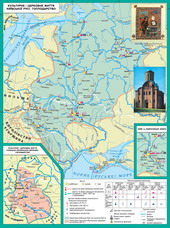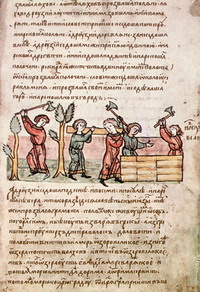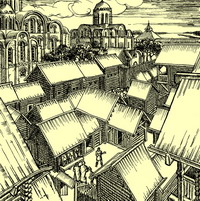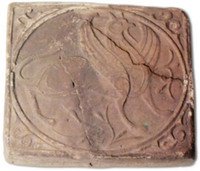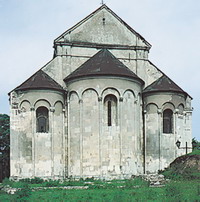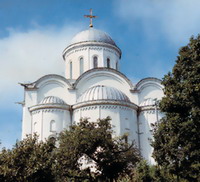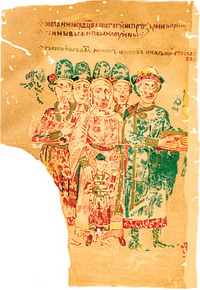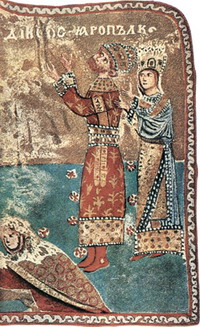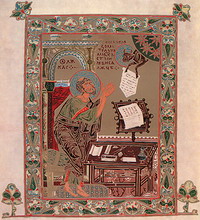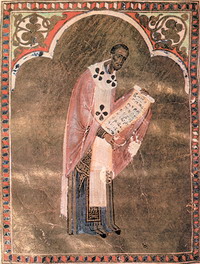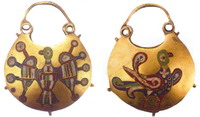art and architecture of Kievan Rus and Galicia-Volyn state
Plan presentation
- building castles and fortifications of the town.
- Urban.
- Stone temple construction of Kievan Rus.
- Features Architecture Galicia-Volyn principality.
- Visual Arts.
- Portrait miniature.
- jewelry.
Timeline
|
989 - 996 years |
construction of church tithes. |
|
1017-1037 he |
construction of Saint Sophia Cathedral, the construction of fortifications around the "city of Yaroslav", "Golden Gate" in Kiev. |
|
1073-1078 he |
Construction Assumption Cathedral Cave Monastery in Kiev. |
|
1108 - 1113 рр. |
Building Michael's Golden-Domed Cathedral of St. Michael's Monastery in Kiev. |
|
1157 |
Construction of the Assumption Cathedral in Galich. |
basic concepts and terms
Icons - in Greek "picture, image - the image of Jesus Christ, God, saints, the events of Holy Scripture. Icons created by certain rules - the canons, which could not be changed. In this one of the main differences from the picture icons.
Prayer - the default text that is spoken while processing a faithful God, Jesus Christ, Holy Spirit, the Blessed Virgin, the saints. Talk of man and God.
Oranta - Icon of the Mother of God, who pray, lifting up his hands up.
Mosaic - Appliances decorating walls and floors, which cement-based in a certain order, the small pieces of colored stone or glass - smalt.
Fresco - paintings with special paints on raw tynku.
Book thumbnail - artwork that decorated illuminated manuscripts .
chandelier - chandelier in an Orthodox church with many candles or lamps.
fibula - Metal clasp clothing that is both decoration .
main presentation
1. Construction of forts and fortifications of the town
- For typical ancient Russia were wooden and earthen defensive fortifications.
Such strengthening - reliability is not inferior stone, they were difficult to destroy and easy fix.
-

 The main part of town castle at that time were log-house - garden .
The main part of town castle at that time were log-house - garden .
Inside - them covered up with earth, and the sides of earthen slopes skriplyuvaly with auxiliary constructions.
- To provide more rapid slope it is sometimes fortified with the outside of source stack.
- Actually, the slopes and formed earthen ramparts. Inaccessibility and provide fortification ditches.
- example of ancient defensive fortifications that have survived to this day, may serve as shafts Belgorod (now the village Bilhorodka Kyiv region) - a mighty fortress, laid Volodymyr the Great.
Ring - city fortifications had several gates. Gates placed in wooden towers or between two towers.
- Nadvorotni stone towers were sometimes (Sofia gate "the city of Vladimir in Kiev), on special occasions over the gates of the church built disgusting.
- before the gates were thrown through the ditches, wooden bridges (Ovruch), sometimes raised by special devices.
2. Urban
-
 Big City consisted mainly of three parts. First - it Detinets, is the oldest part of town, fortress, fortified walls, ramparts and ditches.
Big City consisted mainly of three parts. First - it Detinets, is the oldest part of town, fortress, fortified walls, ramparts and ditches.
- Detinets sporudzhaly city to butt, as in ancient times it is called Hill .
- On kremlin, or Mount sporudzhaly courts and by the boyars, the most important churches and cathedrals.
- kremlin were different sizes: from 10 acres in the largest cities (Kyiv, Pereyaslav) to 0,5-1 hectares in the smaller centers.
- second part of the city was devious "city" (another name - division ) .
- Often it is built with floor-party stronghold and also surrounded by fortifications.
This part of the then - reached the city in large cities of 50-100 hectares.
- Here lived artisans and merchants, there was a shopping square, numerous churches and monasteries.
- Outside city fortifications were suburb - side, or end.
Their artisans settled - a specialty: Kozhemyaka settled near water, pottery - clay at the exit and so on.
- Buildings Old Bridge was less dense than the development of cities in Western Europe and Byzantium. But the land remained for the small schools.
- buildings placed in rows, between which left the passage - the street.
- Direction streets of ancient cities often depend on the terrain.
- they see eye to the commercial area, near the city gates or kremlin.
- main street, mostly passed through the main gate of the outskirts "city" to the kremlin.
- Streets vymoschuvaly wooden flooring. However, it happened big paving stone blocks, hewn from the side one, or a broken brick.
- main sources for urban construction with wood.
3. Stone temple construction of Kievan Rus
-
 stone in the construction of our ancestors began to use in the 10 century.
stone in the construction of our ancestors began to use in the 10 century.
- oldest stone building - princely palace, was discovered by archaeologists in Starokyivska mountain.
In - chronicles mention this building was under 945
During - 989-996 years in Kiev, stone built house Virgin , known as the Tithe Church - First Christian stone church of Kievan Rus.
Stone construction - pozhvavylosya especially for the reign of Yaroslav the Wise.
- In Kiev, then the largest cathedral was built in the state - Sofia Kyiv , Golden Gate, George temples and monasteries Irininskaya.
Construction - unfolding not only in a capital city. In Chernigov Prince Mstislav Vladimirovich in 1036 laid the Transfiguration Cathedral.
- prominent memorial Old Rus architecture was Cave Monastery Assumption Cathedral, was built during 1073-1078 he
- He has become a model of church architecture. Thus, in 1108-1113 he was a great Kyiv Prince Michael II of Kiev Svyatopolk-built St. Michael's Cathedral, is largely, though in somewhat reduced form, repeating the Assumption Cathedral .
- noteworthy that the majority of known now masonry architectural monuments were built during the disintegration.
- Only in Kiev in 1919 then built of stone buildings. Above the town sprung up, including, dome church of the Saviour on Berestov (1125), Virgin Pirogoscha on Podil (1136), the interior of the church and others.
- Many churches appeared in Chernigov. Excellence and skill of Boris impressive cathedral, the Assumption Cathedral Eletskogo monastery Illinska Bloc and the church.
- building a temple, Ruthenian Byzantine artists used techniques inherited from the architecture of ancient Rome.
- example, the technique is derived from starodavnorymskoyi way of laying a thin brick - plinthoi - on limestone solution with a blend of pure brick.
4. Features Architecture Galicia-Volyn principality
-
 If the lands of Volyn builders comply with established traditions on the territory of the Dnieper, in the Galician land applied achievements of Romanesque architecture, common in Hungary, the Czech Republic and Poland.
If the lands of Volyn builders comply with established traditions on the territory of the Dnieper, in the Galician land applied achievements of Romanesque architecture, common in Hungary, the Czech Republic and Poland.
- features of Galician architecture is extraordinary variety of types of buildings for decoration often used white stone wall covering and method of ceramic relief tiles depicting griffins, eagles, warriors, with floral and geometric ornaments, etc..
-

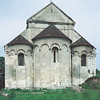 architecture blossom Galician land reached in 12 century. Under the reign Rostyslavychiv. In a capital city there appeared Murovanye princely palaces, temples, fortifications.
architecture blossom Galician land reached in 12 century. Under the reign Rostyslavychiv. In a capital city there appeared Murovanye princely palaces, temples, fortifications.
- most notable monument of Galician architecture is grand Assumption Cathedral in Galicia, was built in the mid 12 century.
- majestic cathedral, which was slightly smaller than the Kyiv Sophia, symbolized the power of Galician principality and its ruler Yaroslav Osmomysl.
- the cathedral during the excavation of the foundation revealed Prince sarcophagus itself.
The only ancient building - Galic, which survived until our times, is St. Panteleimon, is built in the second half of the 12 century. (the modern village Krylos Ivano-Frankivsk region).
- In the 13 century. significant architectural center was Hill, where tradition continued to develop Galician architecture.
- Unfortunately, none of the architectural monuments of Chelm was not preserved, but the Galicia-Volyn chronicle spoke of John Chrysostom Church, built by Prince Danilo and resumed after the fire Hill 1256
- Among surviving church architecture is the oldest Volyn Assumption Cathedral in Vladimir , built by Prince Mstislav II of Kiev in 1160
- In the 13 century. in western Volhynia, a new type of defensive structures - large defensive towers donzhony , built of stone or brick.
5. Visual Arts
-
 Among the attractions of contemporary art the most impressive monumental image - mosaic and Murals that decorated temples.
Among the attractions of contemporary art the most impressive monumental image - mosaic and Murals that decorated temples.
- masterpieces of world-class mosaic is Sofia and St. Michael Cathedral in Kiev. The technique of mosaics and their artistic expression affected Byzantine traditions, but researchers believe that they created Russians and masters.
- even greater originality marked the Russians Murals - the main type of contemporary monumental art.
- Like mosaics, frescoes in churches were created by Ruthenian Byzantine traditions.
In - mosaics and frescoes, temples decorated icons .
- first icons were brought to Russia from Byzantium. Sometimes such information later. Yes, well respected in Russia was Vyshhorod icon of Our Lady .
- brought her in the middle of 12 century. from Constantinople.
She decorated the house - Saints Boris and Gleb in Vyshgorod where Prince Andrew Bogolyubskii 1155 it moved to Vladimir-on-Klyaz'ma.
- in 2000 in Volhynia vidnayshovsya another masterpiece painting of Constantinople in 1911 - 12 century. - Chelm icon of the Virgin.
Sources - kept information about one of the first Russians ikonopystsiv - A Wizard Alipiya.
- From it originated Paintings of famous school of Kiev-Pechersk Monastery.
- unique attraction of this center is a painting icon of the Virgin with Saints Anthony and Theodosius Caves , which according to latest research, dating from the beginning of 12 century.
orthodoxy of contemporary art related to the nature of his church, as mosaics, frescoes and icons were decorated temples. Most of them depicted Jesus Christ, the Virgin, saints, apostles, martyrs, biblical scenes and more. For each of these images, there were religious orders, expressed in a certain iconographic tradition. Because the main targets set just before the art was a visual art opening means leading ideas of Christian faith.
- Over time, especially in an era of disintegration and the Mongol evil, relations with the Byzantine iconography of the Ruthenian tradition began to weaken.
- Ruski artists, not rejecting the Byzantine regulations increasingly confident created his own icon-painting school.
- most prominent and most distinctive landmark painting of Culture of Ukraine in the princely iconography is discovered in the mid 80's 20 cent. and returned from oblivion thanks to the restoration icon of the Virgin (the last third of 13 century.) of the Assumption Church in the village Dorogobuzh Volyn .
Ukrainian - famous icon painting of the first half 14 century. is with Virgin Protection Church in Lutsk.
6. Portrait miniature
- masterpieces of world art is thumbnail «Ostromirov Gospel» (1056-1057 biennium).
Book - decorated with numerous initials, miniatures and three page "thumbnails depicting the evangelists John, Mark and Luke.
- interesting example of the art book is a miniature «History Computerization Svyatoslav" 1073
- the second sheet of the book contains a thumbnail which depicts Prince Svyatoslav Yaroslavych with his family.
- in the "History Computerization is many other different patterns. Thus the fields shown signs of the zodiac: Sagittarius, Virgo, Unicorn, lobster and more.
- valuable example of ancient art book is a page thumbnail, vshyti Latin manuscript in the late 10 th century. - Trirskyy Psalms .
- This book was brought to Russia Polish Princess Gertrude, when she married the great Kiev prince Iziaslav Yaroslavych.
- Between 1078 - 1087 рр. manuscript was supplemented with prayers for the son of Gertrude Yaropolk and five new thumbnail portraits of the duke's family.




7. jewelery
- One of the most common types of metal craft art was casting .
- ancient wizards cast a lot of things - from tiny buttons to the church bells.
- example of artistic casting a big copper chandelier that was found in Kiev at the hem.
- Significant share of Russians acquired territory of forging and coining copper, silver and gold.
- example of skilful chasing is an icon of the Apostle Paul, found in St. Sophia Cathedral. Icon made on very thin copper plate and covered with gold leaf.
- Russians liked to decorate their goldsmiths wares inlaid with gold and silver.
- jewelery adorned as Chernykh, skannyu, gilt. However, the most precious things combined several techniques of decoration.
- Among the most popular ornaments were bracelets, earrings, rings.
- And the amazing work of goldsmiths Russians were cloisonn
- Technology enamels came to Russia from Byzantium and was very difficult.
- about artistic excellence Kiev enamels show in particular, gold earrings.
- unique items of art and gold are two gold tiaras from the prince of ceremonial dress, found in the village. Sakhnivtsi Kiev and Cherkassy region.




 English
English

 The main part of town castle at that time were log-house - garden .
The main part of town castle at that time were log-house - garden .  Big City consisted mainly of three parts. First - it Detinets, is the oldest part of town, fortress, fortified walls, ramparts and ditches.
Big City consisted mainly of three parts. First - it Detinets, is the oldest part of town, fortress, fortified walls, ramparts and ditches.  stone in the construction of our ancestors began to use in the 10 century.
stone in the construction of our ancestors began to use in the 10 century.  If the lands of Volyn builders comply with established traditions on the territory of the Dnieper, in the Galician land applied achievements of Romanesque architecture, common in Hungary, the Czech Republic and Poland.
If the lands of Volyn builders comply with established traditions on the territory of the Dnieper, in the Galician land applied achievements of Romanesque architecture, common in Hungary, the Czech Republic and Poland. 
 architecture blossom Galician land reached in 12 century. Under the reign Rostyslavychiv. In a capital city there appeared Murovanye princely palaces, temples, fortifications.
architecture blossom Galician land reached in 12 century. Under the reign Rostyslavychiv. In a capital city there appeared Murovanye princely palaces, temples, fortifications.  Among the attractions of contemporary art the most impressive monumental image - mosaic and Murals that decorated temples.
Among the attractions of contemporary art the most impressive monumental image - mosaic and Murals that decorated temples. 







